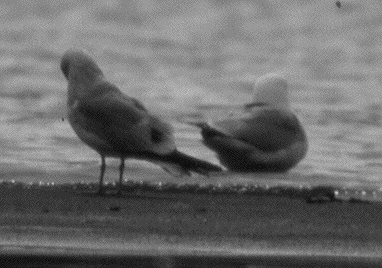The bird was seen in the north Okanagan Valley, British Columbia near a city called Vernon (the bird was at the north tip of Okanagan Lake.)
The bird was only seen on 29 Mar 2003 and was never relocated.
At first glance, I saw the bird from the rear and thought that it was a
California Gull with its greenish legs. I thought it seemed rather light
for California Gull then as it turned its head I thought it was a
Ring-billed Gull but the legs were the wrong colour. As I looked at it
further, I noticed that indeed it was a Mew Gull but a rather odd-looking
one.
Description:
Soft parts:
the bill was long and straight and rather bright for a young bird. The
bill was yellow with suggestion of olive colouring and there was a black
subterminal smudge (not as defined as the ring on a ring-billed Gull) on
both the upper and lower mandibles. The bill was yellower than the
legs. When seen in profile the bill approached the length of Ring-billed
but not in depth., the bill was definitely slimmer and from a distance of
75 meters, I could see through the narines, thus these breathing holes were
quite large. The legs were greenish-yellow and seemed to be a bit longer
looking than those of Mew, particularly the amount of exposed
tarsus. Although this is rather subjective, this was my impression.
Head: the head shape was not as 'cute' or as round as that of our Mew
Gulls. Instead, the head appeared more angular especially on account of
the slope to the forehead, less steep thus approaching the look of
Ring-billed Gull.
The markings on the head were not as smudgy as I have seen on Mew. The
crown in particular showed more fine streaking than what I have noticed on
Mew and the smudging was more concentrated around the nape and lower sides
of the neck. The eye was large and was yellow-brown in colour, not as dark
as that of Mew yet not as bright as that of Ring-billed. The head-streaking
diminished below the eye leaving an area encompassing the lower auricular
region and chin to be rather white/clean.
Body:
The shape of the bird seemed to approach the shape of Ring-billed. It was
a bit more elongate-looking and not as small and rounded-looking as Mew
often is. The bill length and forehead slope may have exaggerated this
appearance. The mantle feathers were adult feathers, darker and bluer than
nearby Ring-billed and noticeably darker and bluer than the bleached-gray
tones of the wing coverts. In the backlit situation the bird was under, my
first impression was that the mantle feathers were lighter than what I
would expect for Mew but then as the clouds covered the sunlight the
contrast between mantle feathers and wing coverts was much more apparent
and seemingly darker than Mew. In other words, I would not be prepared to
say whether I thought the mantle shade was darker or lighter than typical
Mew. This would of course be particulary hard to objectify since there
were no other Mew present. The tertials were partly moulted, some being
adult tertials but a few still retaining black sub-terminal centers that
were easily visible at a distance, these black areas seemed to be followed
by a light gray area then white tips. The wing coverts were light gray
with no brown tones present and they looked rather frayed.
The primaries were brownish-black with very thin lighter fringes. P 10 had
a single mirror present althought this was seen from below as the bird was
preening and was not visible from above since P9 was of very similar
length. The primaries extended well beyond the tail with P7 meeting the
tip of the tail. The tail was largely white with a broken black band
present at least on the outer webs of the tail feathers, not clearly
visible on the standing bird unless it would preen or fan its tail. While
the bird preened, I was able to see light brown horizontal barring on the
upper tail coverts. The breast and undesides of the bird seemed to be pure
white.
Discussion: This bird would appear to be in advanced basic II
plumage. The softpart colouration seems brighter than one might expect on
a 2nd year bird but the moult sequence would be correct for a 2nd year bird
although I am surprised I did not see any brown tones in the wing coverts
(of the standing bird since it was not seen in flight).
I would eliminate L.c.brachyrhynchus due to the length/shape of the bill,
light-coloured eye, smudging on the bill, shape of head.
I would eliminate L.c.canus due to eye colour and prescence of
dark-centered tertials. The latter I understand to be gone by second year
in canus moult.
I have no means to separate kamtschatschensis form heini except that I
believe the
former is many times more likely to occur here.
I look forward to any feedback on this sighting.
Click on the thumbnails:

|

|

|
| A | B | C |
